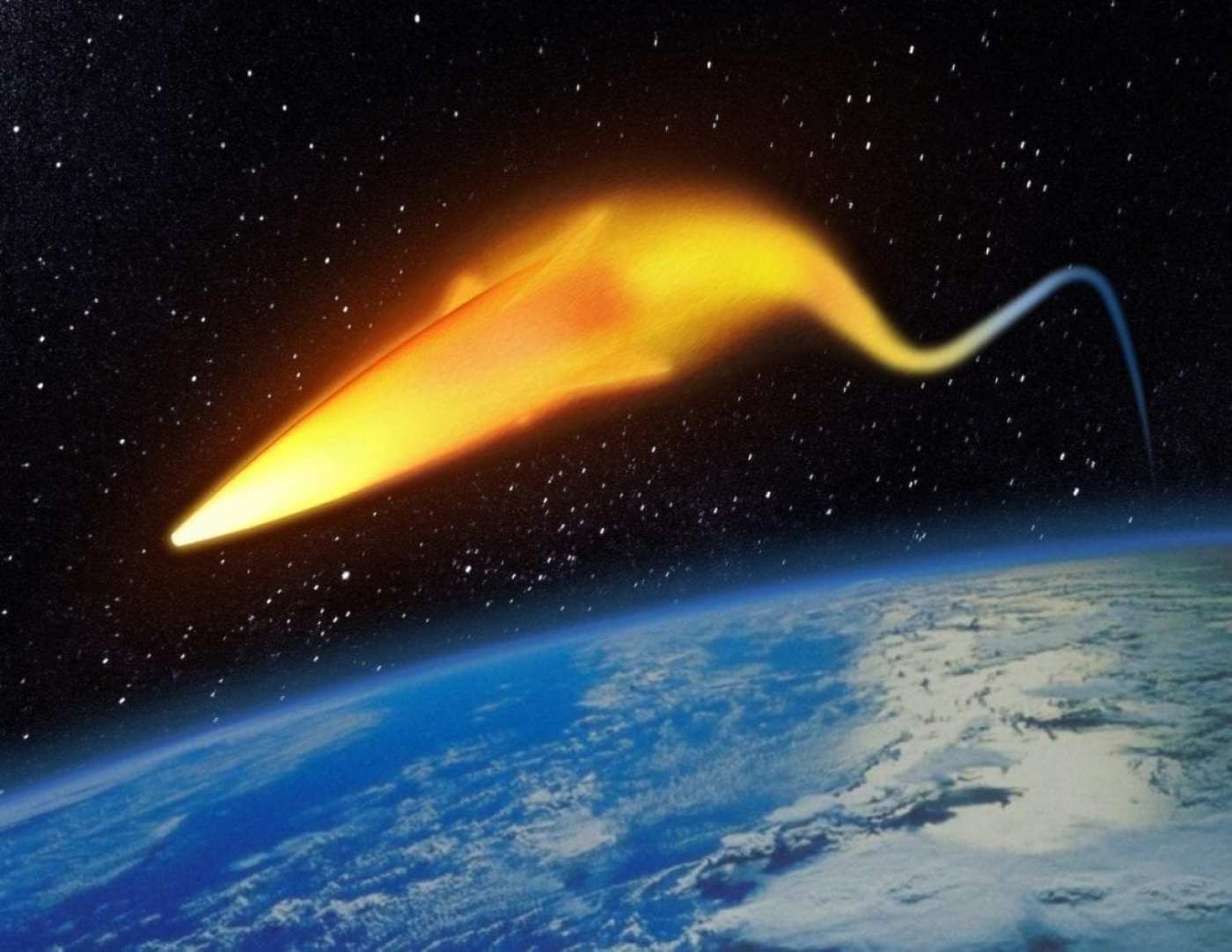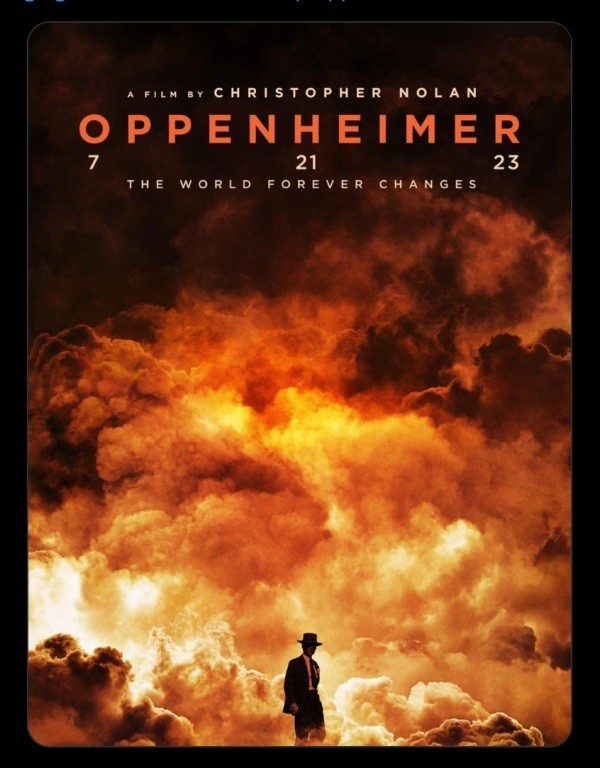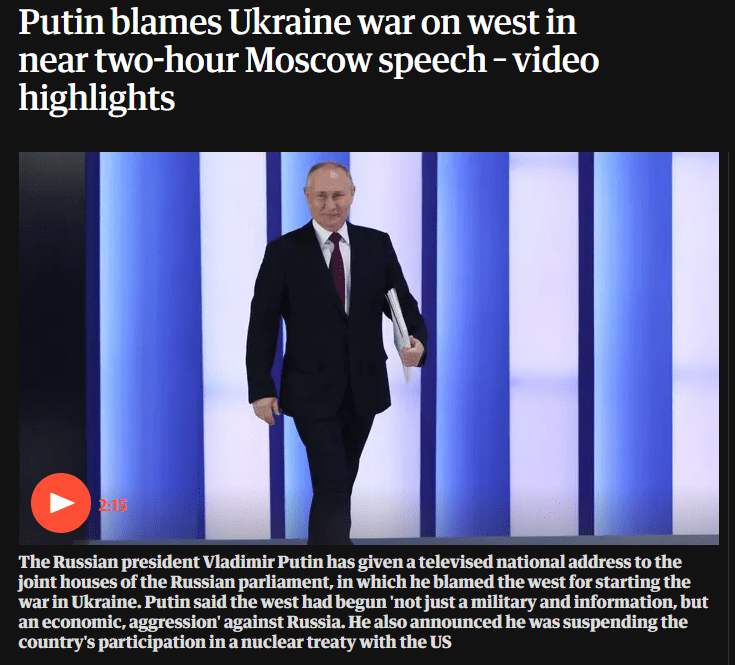* https://strategicdemands.com/nuclear-war-a-scenario/
—————————-
2024
War in the Mideast Threatens to Become Regional — and International
Reverberations as Images of War and Costs of War Spread
Far from the Middle East, in Los Alamos, New Mexico, an outpost in the desert where ‘the Bomb’ was created
a New Generation of Nuclear Weapons Is Being Prepared
Multiplying Pits ‘n Triggers
Multiplying Pits Mean Multiplying Nukes



They built it, then they warned the world about nuclear proliferation
Looking back, we watch an Academy Award winning movie
Oppenheimer — the tragic legacy of ‘the Bomb’
StratDem: A Legacy of ‘Perpetual Insecurity’
Those who envisioned, designed and built the Bomb began warning of nuclear dangers and proliferation even before the Bomb was first used in Hiroshima and Nagasaki….
See GreenPolicy360’s review of the film Oppenheimer and the Siterunner’s recollections of a life working against nuclear weapons proliferation.
In 2024, the world witnesses a war in Ukraine that began with an underlying threat of nuclear weapons, next generation ‘modernized’ nuclear weapons and delivery systems. An expansion of NATO and a collapse of nuclear arms control agreements marks dangerous times and new proliferation dangers, including artificial intelligence (autonomous weapon systems) and machine-algorithms inserted into command & control systems.
The technologists and engineers who took physics and converted atomic energy into weapons are now in history, warning from the past — Oppenheimer was one of many who raised warnings of catastrophe while others drew their pay and pressed on with tech-for-hire city- and nation- and region-destroying nuclear weapon capabilities.
-
https://greenpolicy360.net/w/File:Oppenheimer_movie_-_2023.jpg
-
https://www.greenpolicy360.net/w/Nuclear_Weapons



Next Generation Nuclear Weapons Deployment
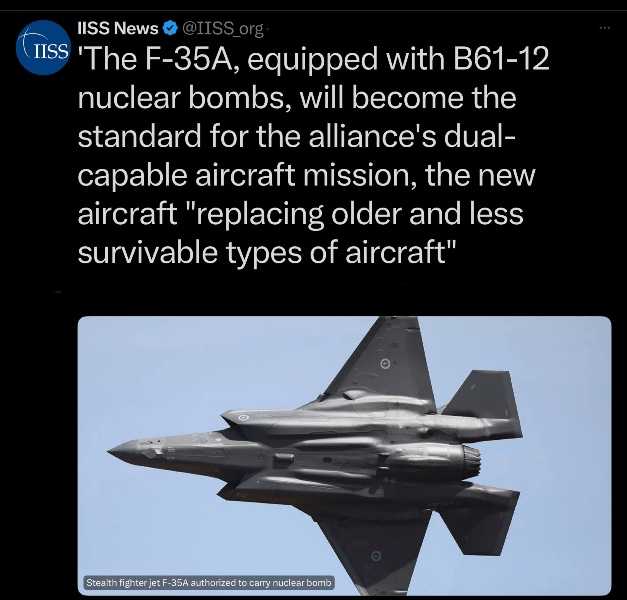
March 15, 2024 / F35-A / Forward-based, nuclear-capable platform
WASHINGTON – MARCH 11, 2024
The Department of Energy’s National Nuclear Security Administration (DOE/NNSA) released its portion of President Biden’s Fiscal Year 2025 Budget. The proposal reflects a demanding, expanded mission…
It will advance nonproliferation [StratDem: No, it advances and accelerates a Cold War 2.0 and a Nuclear Arms Race 3.0]… in response to deteriorating strategic stability conditions…
“President Biden’s FY 2025 Budget reflects today’s real-world conditions and our need to deliver while transforming the Nuclear Security Enterprise,” said Under Secretary of Energy for Nuclear Security and NNSA Administrator Jill Hruby. “We appreciate the long-standing bipartisan and bicameral support from Congress that allows us to design and deliver a modernized stockpile, forge solutions with allies and partners that enable global security and stability [StratDem: The ‘solutions’ proposed will not ‘enable global security and stability.’ The rapidly increasing nuclear weapons budget will produce predictable multi-nation nuclear proliferation and an accelerating nuclear arms race. The observable consequence of deploying forward-based, nuclear-capable, ‘survivable’ nuclear weapons and next gen [e.g., F-35A] delivery platforms, will continue an escalating arms race. The consequences of nuclear weapons development/deployment are increased risk and reduced national and international security.]
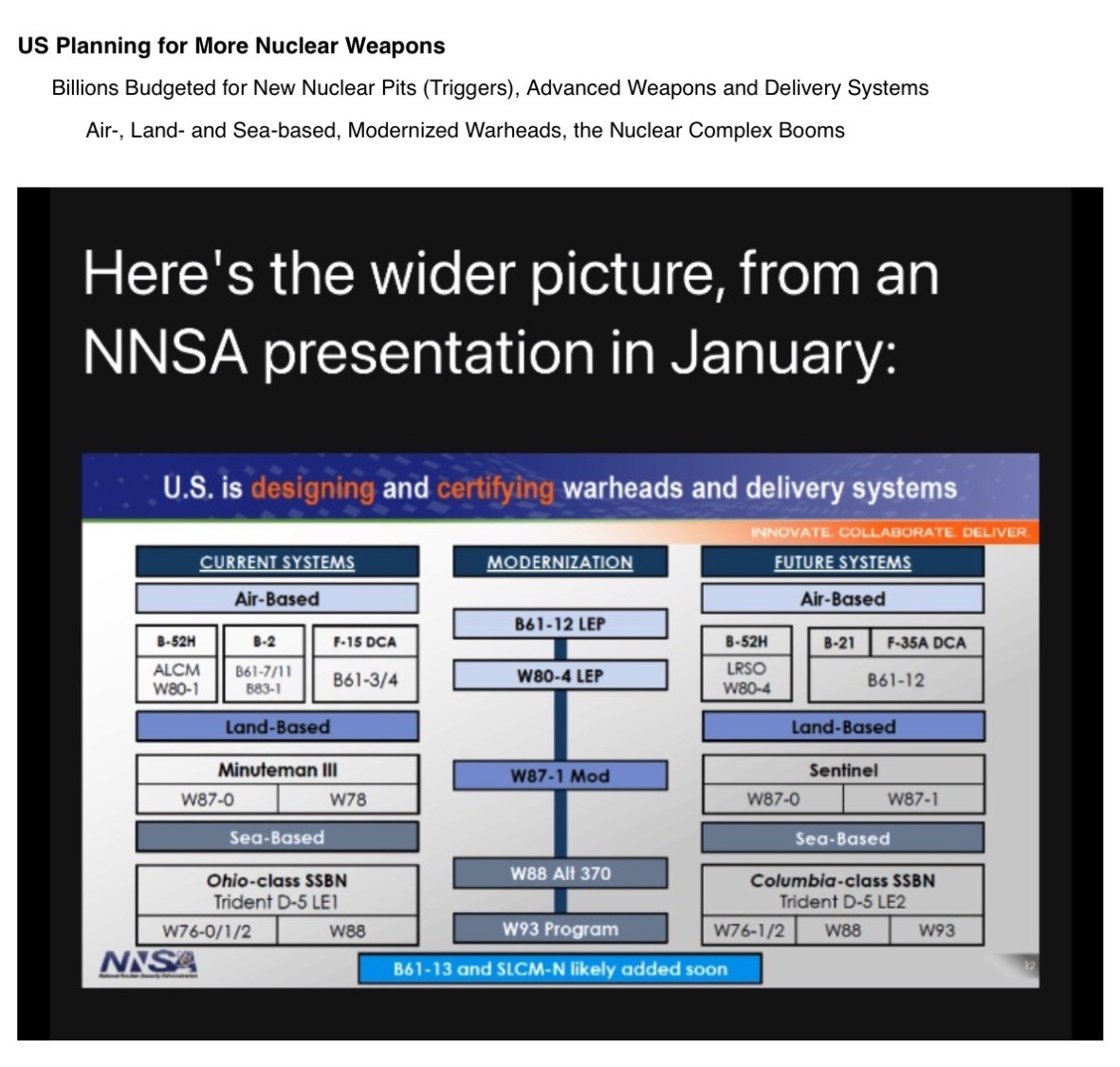

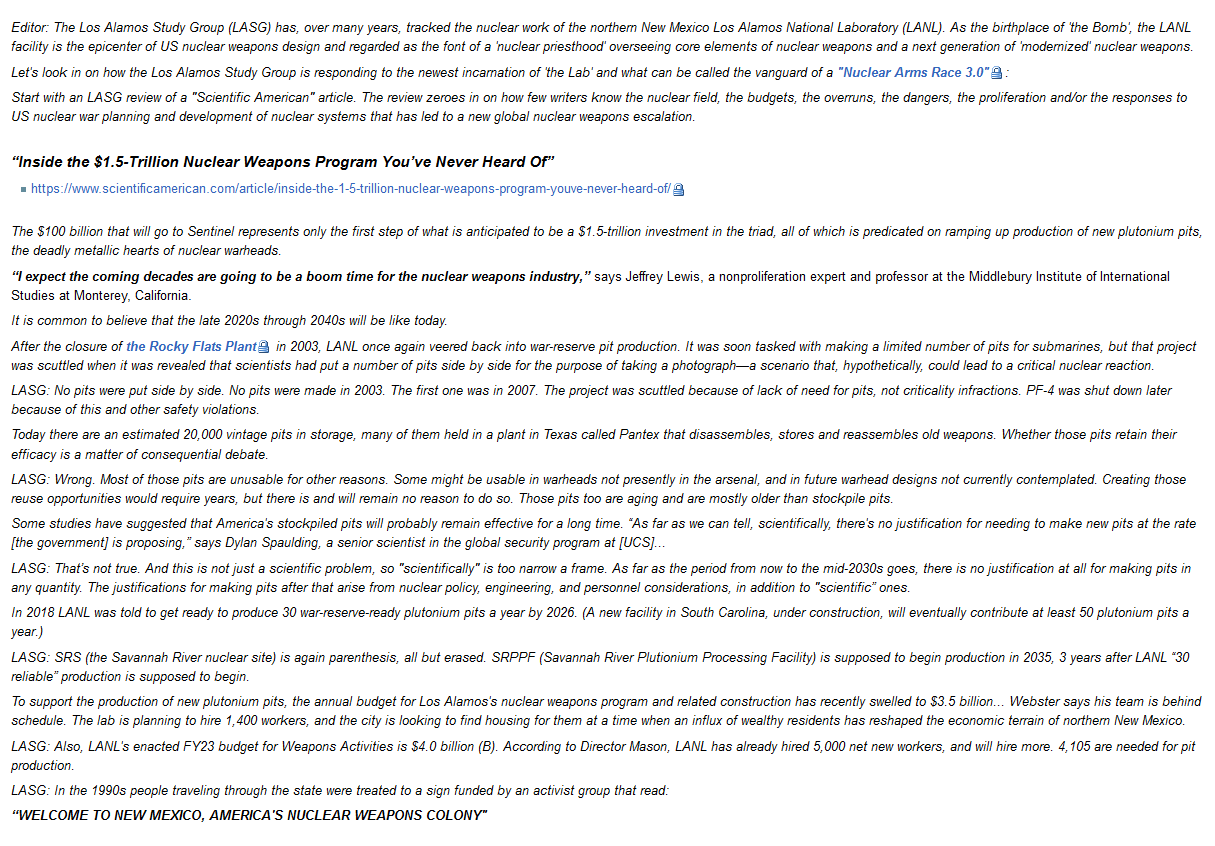

Strategic Demands’ 1.0 to 3.0 Nuclear Arms Race classification
The following provides a development chronology of the ‘Cold War’ and ‘Nuclear Arms Race’.
From Trinity Site beginnings in a desert called Jornada del Muerto in New Mexico, near ‘the National Lab’ in Los Alamos that was the ‘birthplace of the Bomb’ until today, were a new, increasingly dangerous era of nuclear proliferation. The world looks on…
Arms Race 1.0 — The origins of the nuclear arms race, as predicted by many, began with the test of the Soviet Union’s first nuclear weapon in 1949. This era last through the 1950s and development of thermonuclear weapons, testing, and ended with the confrontation and near-use of nuclear weapons between the United States and Soviet Union during the October 1962 Cuban Missile Crisis.
Arms Race 2.0 — The imminent demise of 1962 prevented by a Kennedy-Khrushchev agreement, led to a series of agreements to draw down, over years, each countries nuclear weapons arsenals. From the mid-1960s ti the late 1990s, a profound number of nuclear and weapons of mass destruction treaties/agreements were signed. Thousands of nuclear weapons were by treaty taken out of the US and Soviet (Russian) arsenals, many of them were the most lethal, largest city- and region-destroying weapons that scientists were predicting would bring on global devastation and ‘nuclear winter‘. This era of nuclear development, which included a brief opportunity for a ‘peace dividend‘ and further nuclear drawdown after Soviet Union became the Russian Federation, came to a close in 2001 with war in the Mideast/Near East with the announcement of the US Bush Doctrine memorializing ‘right’ of first strike, preemptive war
Arms Race 3.0 — Announced ‘modernization’ of US nuclear weapons systems has, as Strategic Demands presents, led to a collapse of nuclear weapons treaties and weapons systems drawdown. The current era presents collapse of monitor and verification treaties. The rapid scaling up of nuclear weapons and delivery systems by the People’s Republic of China/CCP and nuclear weapon holding countries including North Korea, India, Pakistan, Israel is occurring in a backdrop of war and increasing risks of use. The Russia-Ukraine war has brought a resurgent NATO-EU policy with ‘full-dimension’ air/land/sea warfare supported by US deployments of nuclear weapon delivery platforms, including — B-15/B-2/B-52/F-35 ‘strike forces’ and various iterations of cruise missiles and tactical nuclear weapons. Russia and China have drawn closer. Mutual security, ‘entangling alliances’, emerging threats and risks of miscalculation, mistake, or misjudgment, bringing on a nuclear exchange, are all too real. Nuclear Arms Race 3.0 is now beyond dangerous…
Too Close to “the Apocalypse”
Begin with ‘Religious’ Practice & the Verities of Power
Millions, hundreds of millions, billions of dollars go annually to a “nuclear priesthood”, as it’s been called. The priests who oversee the atomic weapons, ‘little tactical’ ones, more deadly and powerful than used at Hiroshima, to ‘megaton strategic’ ones capable of erasing cities, regions, and destruction, devastation beyond comprehension…
* https://strategicdemands.com/stewards-of-the-apocalypse/
Since the conception of ‘the Bomb’ at ‘Trinity’, the priest, acolytes and congregations of ‘the Bombs’ have ritually continued their death delivering practices and preparations everyday.
In the event the ritual reaches its raison d’etre then that’ll be the end of life as we know it on Planet Earth.
As Planet Citizens we should all be aware of the danger and risks of going along with this ritualistic reality — and we, at Strategic Demands, continue to call for sanity in our nation’s strategic policies.
One of the recent events that we have pointed as a clarion call involves a famed ‘whistleblower’, Daniel Ellsberg, who passed away on June 16, 2023. Although many know of the “Pentagon Papers”, the history of the Vietnam War that Dan Ellsberg was responsible for putting together for Robert McNamara, then releasing to the American public, few know that Ellsberg was a nuclear war planner.
Strategic Demands knows — and our StratDem founder-editor was involved back in the day with Dan and his writing.
Today we remember a moment on the beach in California as Dan prepared “the papers” and prepared to face his fate as he packed to leave for the East Coast, Harvard, Cambridge, where he planned to distribute the insider view he had of the war to newspapers — the NY Times, the Washington Post and others.
Let us reflect — not genuflect at this moment.
Here are personal memories of Dan from back in those days…. and then memories of a recent documentary film that revealed how close the US came to launching a nuclear war in Vietnam
In Memory of a Man Named Daniel
By Steven Schmidt
June 17, 2023The moon was bright that night as I visited Daniel Ellsberg at his house on the beach in Southern California. It was mid 1970 and Dan was surrounded by boxes. “Papers,” he called them. He was packing to leave for Cambridge and a new position at MIT and he was worried that night as he showed me the study he had put together at the Rand Corporation in Santa Monica.
As we sorted through documents I noticed some had Top Secret stamped on some of them. I learned later that these were part of the 7000 page, forty plus volume report soon to be called the “Pentagon Papers.”
Dan spoke of President Nixon and famed advisor, Henry Kissinger with first-hand knowledge. He mentioned he had met with Kissinger recently at Nixon’s San Clemente estate. I remember his fear, both that Nixon and Kissinger were repeating mistakes of previous administrations as “the Papers” demonstrated, and how the truth needed to go public. He broke off from the packing and said let’s go, “I need to swim”.
Dan was depressed, I knew, and I was not going to convince him not to go into the loudly crashing night surf. I watched as he plunged into the waves. He then reappeared for a moment in the moonlight. He swam straight out, then disappeared. I waited on shore looking out at the dark ocean. Time passed, no sign of Dan. I began worrying. Is this the end of Dan Ellsberg? Did I just witness Dan ending it all? Did a riptide take him? I walked up and down the beach searching. Suddenly, Dan walked out of the surf, nodded then sprinted back toward the house. He quickly shifted back into work mode. Something happened, he had new resolve.
Today as I reflect on the life of Dan Ellsberg and the announcement of his death, I can say he lived life like few others. He pursued the truth and facts in a way that was astounding and committed. He went on to prove in his actions that he was brave to put his life on the line for the sake of the American people. His decision was purposeful. He thought deeply about the consequences. That night under the moon I saw his fear, and I saw his resolve.
A few months later, when Daniel released the Pentagon Papers to a NY Times writer, Neil Sheehan, the truth came out. Dan’s history of the war study subsequently led to the end of the Nixon presidency and, as a consequence, the end of the Vietnam War. Dan would later say the Pentagon Papers themselves didn’t directly end the war, but the American people learned of the “evidence of a quarter-century of aggression, broken treaties, deceptions, stolen elections, lies, and murder”. This, with Nixon’s resignation, brought on the end of the war.
I learned over the course of our relationship that Dan Ellsberg was gifted, literally. I still say he is the smartest man I’ve ever known. His 2002 book “Secrets: A Memoir of Vietnam and the Pentagon Papers” is a must read. “On the evening of October 1, 1969, I walked out past the guards’ desk at the Rand Corporation in Santa Monica,” he writes, “carrying a briefcase filled with top secret documents, which I planned to photocopy that night… How I came to do this is the focus of this memoir.” Dan’s memoir is a true American story.
Beyond the Pentagon Papers and resulting demise of the Nixon presidency, Dan Ellsberg’s follow-on 2017 book “The Doomsday Machine: Confessions of a Nuclear War Planner” later explained the inner machinations of the nuclear war complex. He was, as a younger man, a systems man and followed orders. His nuclear war gaming was a Pentagon nuclear plan that he, as an old man, brought into the light with this revelatory book. The extent of humanity’s threat to life on earth is part of Dan Ellsberg’s legacy now.
Daniel Ellsberg’s life is a testament to what generations to come have to deal with — perpetual wars, the realities of nuclear weapons, modern states with awesome powers for good and bad. Dan Ellsberg revealed and pointed us to harsh realities.
Will we listen to Dan Ellsberg’s message that he, risking all, brought to us?
Daniel Ellsberg, after all is said and done, was a man who taught us. He was a man of peace. Dan was a believer in the power each of us has to make a difference and move toward a better world.
Now, in 2023, a PBS “American Experience” event steps up to reveal how close to the use of nuclear weapons and war the world come to in 1969 as a president and his advisor planned to ‘send a message’ to Hanoi. The ‘madman theory’ was Nixon’s strategy, and there were those on his NSC staff — Halperin, Lake, Morris, — who attempted to change the ‘craziness’ emanating from the presidents office…
And there was Daniel Ellsberg, a nuclear war planner, who states, “The bottom line is I believe we would have had the first nuclear attacks since Nagasaki in 1969 had it not been for the (Vietnam Moratorium) October 15th demonstrations and the demonstrations in November.”
* https://en.wikipedia.org/wiki/The_Movement_and_the_%22Madman%22
PBS
The Movement and the ‘Madman’: Public Broadcast System PREMIERE MARCH 28, 2023 ON AMERICAN EXPERIENCE — A nuclear war planner and National Security Policy staff recall how close the US came to using nuclear weapons in Vietnam in 1969
Visit the StratDem ‘Movement and Madman’ page
* https://strategicdemands.com/the-movement-and-the-madman-1969-near-nuclear-use/
The Movement and Madman documentary film
The little-known story of a dramatic showdown between a protest movement and a president
* https://www.movementandthemadman.com/home
* https://www.movementandthemadman.com/history
* https://www.movementandthemadman.com/preview
* https://www.movementandthemadman.com/interviewees
* https://www.movementandthemadman.com/filmmakers
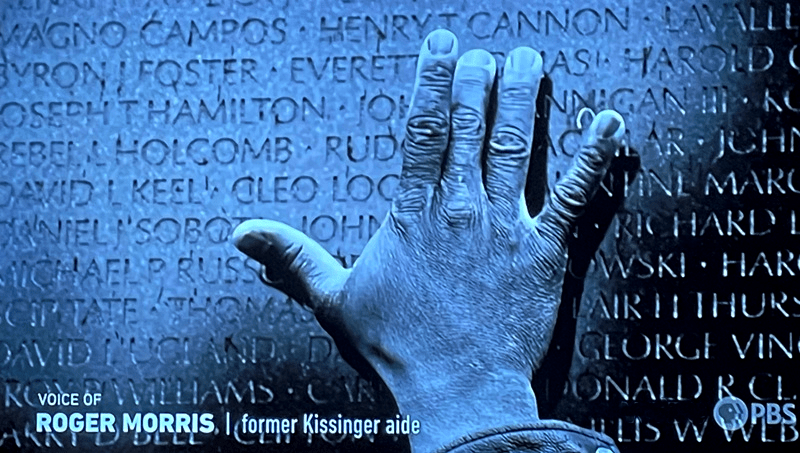

Roger Morris | Roger Morris (bio)
Watch an episode of the PBS 2023 documentary, The Movement and the Madman
* https://www.pbs.org/video/chapter-1-the-movement-and-the-madman-l6lvfr/
In the “Doomsday Machine“: Daniel Ellsberg, recalls the Vietnam Moratorium Peace Movement of October – November 1969 and Nixon’s threats…
In 2023, U.S. PBS filmmakers revisit the threats that were being planned in the White House — and how politics forced a change in a president’s mind.
National Security staff member such as Morton Halperin, Roger Morris, Anthony Lake became heroic in their opposition to Nixon and Kissinger plans to escalate the war in Vietnam.
North Vietnam was, in negotiations, told of a ‘crazy’ Nixon who was saying he would ‘go to a much higher level of escalation including nuclear weapons’
* https://www.greenpolicy360.net/w/Roger_Morris_Bio
* https://www.greenpolicy360.net/w/File:Dan_Ellsberg_-_2017.png
* https://strategicdemands.com/doomsday-machine/
* https://www.greenpolicy360.net/w/File:Dan_Ellsberg_-_March_2023.png
* https://www.greenpolicy360.net/w/File:Doomsday_Machine.jpg
* https://strategicdemands.com/icbms-hair-trigger-launch-on-warning-era-must-end/
* https://strategicdemands.com/nuclear-issues-cold-war-2-0/
* https://www.greenpolicy360.net/w/Nuclear_Weapons
* https://www.greenpolicy360.net/w/File:Moratorium_October_15_1969.jpg
* https://www.greenpolicy360.net/w/File:Moratorium_memory,_Dan-Steve,_Doomsday_Machine_inscription.jpg
* https://www.greenpolicy360.net/w/File:Oct_15,_1969,_Vietnam_Moratorium_Day_in_memory.jpg
Editor: Today, in 2023, we recall the dashed hopes that came with the “End of the Cold War” in the early 1990s. The announcement of the Soviet Union giving way to a Russian Federation, the Iron Curtain falling, Eastern Europe setting new directions, a realignment and new geopolitics was in the air. Some even spoke of chances for a “Peace Dividend” in the US as did Strategic Demands editor who, in the 1992 presidential campaign with California Governor Jerry Brown, worked on a “Platform-in-Progress” with strong peace planks.
Yet, in just over a decade, a new US doctrine of preemptive war and hopes of Nuclear Weapons disarmament, new arms control treaties, transparency, verification, inspections, and nuclear reductions turned to new wars in the Mideast and Near East, new rivalries, and new nuclear weapons planning, budgeting, and next-generation systems.
A US president named Obama would speak to the UN and Americans of nuclear weapons drawdown but a nuclear “modernization” move pushed China and Russia in countering moves. In nuclear terms, the US preemptive, “First Use” strategy acted to change geopolitics.
Strategic Demands had called this a “Cold War 2.0” launch, Eurasia turning toward hard power. A larger stage came into play. Larger strategic goals, control of resources, oil/gas/energy, rose globally. Russia established new power blocs inside and outside their reconstituted state. The Chinese “Belt-and-Road” initiative reached across the continent and into Africa. With China an economic powerhouse, providing manufacturing for the world, the Chinese Communist Party (CCP) turned its military outward to compete with and match the capabilities of the US. Nuclear weapons again became a top priority for projecting power. An alliance between China and Russia grew year by year as both cooperated to counter the United States.
Nuclear weapons have re-emerged and fast-tracked. The nuclear weapons complex budget is rocketing….
♦
The US itself chose to go into a new phase of spending for military capabilities. Nuclear Weapons were high on the list. A “Nuclear Arms Race 3.0”, as StratDem calls it, has powered up even as the existing nuclear arms control agreements, treaties and protocols have collapse one after the other. Today’s generation across the world clearly does not remember the fears of those who ratcheted down thermonuclear Nuclear Weapons. The existential, global threat remains real, a “Nuclear Winter” following Nuclear Weapons use remains a real and present danger. Command-and-Control systems are set to “Launch-on-Warning”. “Usable” precision-guided tranche of Nuclear Weapons, “Dial-Up” tactical, “Bunker-Busting”, “modernized” weapons and accompanying delivery systems that can trigger responses automatically from mega-thermonuclear weapons are being tested now and deployed. The threat, global threat, is real — and the threat is escalating, expanding outward, second-by-second.
♦
The Legacy of the Bomb
July 2023
Via the Bulletin of Atomic Scientists
Fighting a nuclear war is equivalent to national suicide. Make that planetary omnicide.
In the words of Daniel Ellsberg, who passed away last month:
“What is missing—what is foregone—in the typical discussion and analysis of historical or current nuclear policies is the recognition that what is being discussed is dizzyingly insane and immoral:
in its almost-incalculable and inconceivable destructiveness and deliberate murderousness, its disproportionality of risked and planned destructiveness to either declared or unacknowledged objectives, the infeasibility of its secretly pursued aims (damage limitation to the United States and allies, “victory” in two-sided nuclear war), its criminality (to a degree that explodes ordinary visions of law, justice, crime), its lack of wisdom or compassion, its sinfulness and evil.”
* https://thebulletin.org/2023/07/post-oppenheimer-what-we-should-do-to-dismantle-the-nuclear-doomsday-machine/
* https://www.greenpolicy360.net/w/File:Doomsday_Machine.jpg
A “Nuclear Arms Race 3.0” has commenced
A Threatening Speech by the Russian President
War in Ukraine and a New Nuclear Arms Race
Putin announces end of last remaining nuclear control pact …
(CNBC – February 22, 2023) Officials in Moscow appeared bullish today about Russian President Vladimir Putin’s decision announced yesterday suspending Russia’s participation in the New Start nuclear arms treaty — the last remaining nuclear arms control pact between the U.S. and Russia that sought to limit the nuclear arsenals of both countries.
♦
Former Russian President Dmitry Medvedev said that the decision to suspend the treaty was “overdue” and that Russia’s move would have “a huge resonance in the world in general and in the United States in particular.”
Medvedev repeated a Russian claim that the U.S. “wants the defeat of Russia” and that the world is on the brink of a new global conflict. “If the United States wants to defeat Russia, then we have the right to defend ourselves with any weapon, including nuclear,” Medvedev said.
Russian Deputy Foreign Minister Sergei Ryabkov was reported in Russian media Wednesday as saying that Moscow would still be able to “fairly reliably assess” the U.S.′ nuclear potential from outside of the agreement.
“There are national technical means that make it possible to fairly reliably assess what is happening. We, in addition, have accumulated experience in tracking what is happening in the United States, and not only in the United States, in this area, using other possibilities. Yes, this is not the same as information exchange within the framework of the agreement. But the situation has changed radically, so we will proceed from what is available,” Ryabkov told reporters, according to Russian news agency Ria Novosti.
♦
A deal is made in 2010
Negotiations between the Senate and the White House led to billions of dollars over a 10-year period for the National Nuclear Security Administration (NNSA)
Strategic Demands: President Obama’s negotiations to obtain US Senate Republican support for the New START nuclear weapons reduction agreement through Congress led to a multi-pronged ‘land-sea-and-air’ spike in funding to develop new nuclear weapons “modernization” programs. This package deal resulted in two memoranda of understanding which “traded funding for modernization in return for Republican votes.”
Brookings Institute looks back at New START
The Brookings meeting, years later, states the obvious, that the Obama administration “had already committed to a substantial increase in the NNSA weapons budget before New START was signed.” What isn’t stated is the predictable consequence — a counter-response from Russia.
StratDem:
The backstory to the signing of the treaty that delivered vast “modernization” spending increases to the US nuclear arsenal should be more closely considered. Let’s do this in context of Brookings itself.
The Brooking Institute president from 2002 to 2017 was Strobe Talbott who, as Deputy Secretary of State in the 1990s, was instrumental in negotiations with Russia during his years as President Clinton’s advisor on Russian affairs. Strobe Talbott’s relationship with Russia and Clinton goes back to college in the UK, when they were roommates and traveled in Russia.
Strobe Talbott’s acquisition and translation of the book, Khrushchev Remembers
In the 1990s, during the last days of the Soviet Union, the ‘fall of the Berlin Wall, and beginnings of the Russian Federation, as US negotiations with new Russian Federation leaders set groundwork in place for new relationship, a story untold here in this Brookings meeting is key to understanding New START and today’s security concerns.
The US, NATO, EU statements and commitments made to Russia as the so-called Iron Curtain is lifted and ‘the West’ re-engaged with ‘the East’ needs to be recalled, but somehow the Brookings Institute and especially a key player, Ambassador Talbott as a president of Brookings is absent. This background is essential. It is critical to understanding the current claims made by President Putin who, during the 90s, was working in East Germany as a Soviet intelligence officer in association with the Stasi. He watched up close as the Soviet Union collapsed and Putin later explained the loss of “historical Russia”. New challenges loomed as the Soviet Union reformed. New opportunities presented themselves, forward thinking or reactive ‘old ways’.
Strategic Demands’ editor can recall, during work with the presidential campaign of Governor Jerry Brown in 1992, how we drafted a foreign policy speaking of new potential, a “peace dividend” as the Cold War drew to a close. For both the US and former Soviet states, much was becoming possible.
A historic opportunity to move away from the nuclear weapons era and a move toward reinvestment and cooperation was possible, a generational moment. The taking up of the peace dividend and ‘taking a new road’ was not to be as history shows. The Clinton administration with Strobe Talbott have their perspective of this history and I can say, as a policy person in the campaign that drew close to winning the White House, that a Jerry Brown presidency would have taken a different course. Defense conversion, reinvestment in America, larger security definitions and policies.
The Clinton and Talbott Russian Policy – vs a California Governor Brown ‘Peace Divided’ Policy
Now we, at Strategic Demands and our associate GreenPolicy360, refer to as a “New Definitions of National Security”. The policy is, in effect, a “Platform-in-Progress”.
In the 1990s the national and global/foreign policy of the Governor Brown campaign were not meant to become reality at this crucial opportunity in time. The statements/commitments and promises made in the 1990s by the Clinton administration, by Strobe Talbot and US State Department to Russian leaders, were meant to be…
Today we continue to hear the current Russian leader making a case that promises made by the US in the 1990s were broken and commitments made that NATO would not expand with nuclear weapons ‘at the doorstep’ of Russia. The Cuban Missile Crisis is recalled, for example, how the US and Soviet Union negotiated themselves out of a near nuclear conflagration and cataclysmic world war.
♦
Yet, unexplored in the Brookings nuclear weapons story, beyond the promises made in the 1990s is a recall of the quid pro quo demanded by Senate Republican leaders during extended New START nuclear reduction negotiations… In demand for their vote to enable approval of the New START arms agreement, nuclear weapons reductions promised widely in the Obama administration speeches, Republican support would only be forthcoming with increases in nuclear weapons capabilities.
The nuclear weapons modernization came to include next generation ‘smart’ nuclear weapons, more ‘usable’, ‘dial up’ tactical nuclear weapons, and an array of modernized precision, non-interceptible nuclear weapon systems, including development of nuclear-launch platforms such as the F-35 strike forces. The F-35, when enabled to carry nuclear cruise missiles, was seen as game changing, and it was.
The results, as could be predicted by experts and non-experts alike, led to a ratcheting up of Russian — and Chinese nuclear weapons programs. The race to react to US modernization was swift and consequential.
Nuclear weapons ‘experts’ opinions, here expressed at the Brookings meeting, have again been proven to provide specious reasoning and evasion of the consequential results — a profound reduction of security and proliferating nuclear risks to the extreme.
Brookings ‘experts’
… Obama administration officials publicly recognized the important link between modernizing the NNSA complex and maintaining an arms control regime with Russia. Additionally, Creedon argued that the increased NNSA funding for modernization was in large part an effort to downsize the total number of warheads in the U.S. stockpile, produced as a hedge caused by infrastructure uncertainty.
‘A hedge caused by infrastructure uncertainty’?
The consequences of a quid pro quo nuclear weapons expansive modernization are here in front of us… modernization in the form of new, more lethal, more usable, ‘modernized’ nuclear weapons and delivery systems has produced a resulting multi-lateral nuclear arms race that has no signs of slowing… We should have known but we didn’t know and we didn’t act upon what we should’ve known and acted upon.
What we are looking at now is nuclear weapons proliferation, a US nuclear weapons complex with historic spending increases, the national labs and military-industrial complex racing to produce next generation nuclear weapons systems, from pits (weapon triggers) to ‘fin kits and guidance systems’ (upgraded warheads with precision striking capabilities, e.g., “bunker busting” strikes against underground sites, tactical, battlefield ‘utility’). Russians and Chinese, and other nations, are attempting to compete with their nuclear capabilities.
A deeper, more thorough investigation of the US role in ramping up nuclear weapons is demanded as we rethink security policy. It is time for key learnings to be on the agenda — why and how in the 21st century was a nuclear weapons race accelerated? What do we, as democracies facing authoritarian threats, need to do as we go forward? What do we need to do to guide future successful nuclear weapons negotiations, control protocols, verification and implementation agreements?
We need to aim for mutual security, we absolutely need to recognize that a ‘changing world’ demands new definitions of national security.


Ω
Notes:
U.S.-Russian Relations Can Still Get Worse
By Hanna Notte
Hanna Notte, Ph.D. is a senior research associate with the Vienna Center for Disarmament and Non-Proliferation, where she focuses on arms control and security issues involving Russia, the Middle East, their intersection, and implications for U.S. and European policy. She holds a doctorate and M.Phil. in international relations from Oxford University and a B.A. in social and political sciences from Cambridge University. Her contributions have appeared in The Nonproliferation Review, Foreign Policy, The National Interest, and Carnegie, among others.
Dossiers, Compartmentalization, NATO-Russia, Germany-Russia, ‘Unmanaged nuclear competition’, Intermediate-Range Nuclear Forces (INF) Treaty, Russia-UN Security Council
https://www.nato.int/nato_static_fl2014/assets/pdf/2020/4/pdf/2003-NATO-Russia_en.pdf
https://www.themoscowtimes.com/2014/04/03/nasa-hit-by-us-russia-ukraine-spat-a33629
https://www.auswaertiges-amt.de/en/aussenpolitik/russianfederation/218616
https://2017-2021.state.gov/u-s-withdrawal-from-the-inf-treaty-on-august-2-2019/index.html
The Rise and Decline of Global Nuclear Order
Nuclear Perils in a New Era
Project: Promoting Dialogue on Arms Control and Disarmament / April 2021



